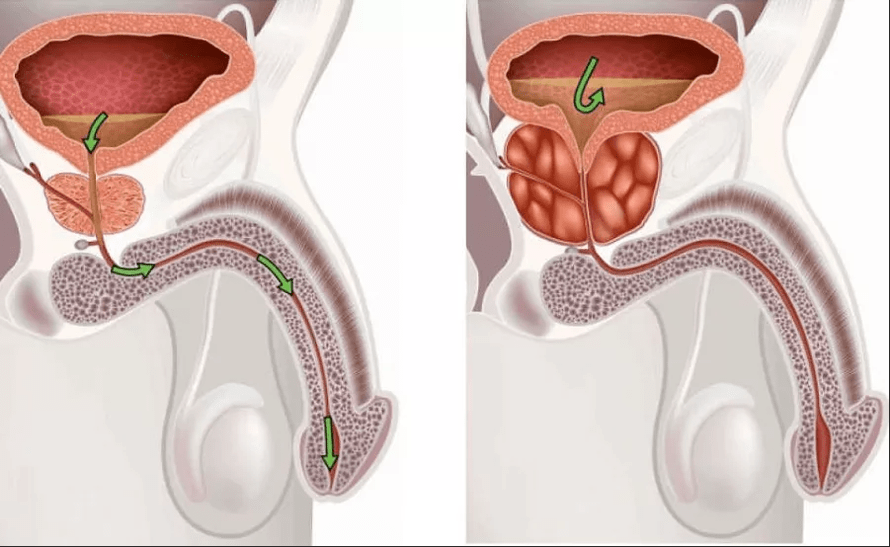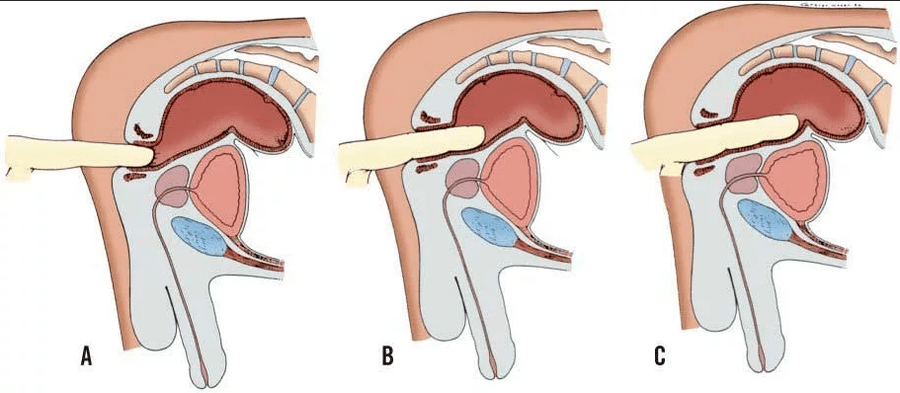Prostatitis is an inflammation of a person's prostate gland.The prostate is located just below the bladder and the size of a chestnut.It surrounds the first section of the urethra and extends to the pelvic floor, which consists of muscles.

The prostate produces secretion, which includes PSA and sperm.PSA makes the ejaculate more liquid.Spermina is important for sperm mobility.
Prostatitis is mainly associated with severe pain in the perineum and anal region.In addition, symptoms such as frequency of urination, pain during urination and pain during ejaculation occur during inflammation of the prostate.
The prostate is relatively affected by inflammation.The probability of prostate infection increases with age.Studies show that most cases aged 40 to 50 years.
Prostatitis syndrome
At the same time, an expanded understanding of the term prostatitis appeared in medicine.With prostatitis syndrome so called, several complaints are summarized in the area of human pelvis, which usually have an unknown reason.The term "prostatitis syndrome" summarizes several clinical paintings:
- Acute bacterial prostatitis
- Chronic bacterial prostatitis
- Inflammatory and non -inflammatory syndrome of chronic pelvic pain
- Asymptomatic prostatitis
Acute and chronic bacterial prostatitis
Acute prostatitis is caused by bacteria.Bacteria pass through the blood to the prostate or spread from bacterial bladder or urethra infection to the prostate.Acute prostatitis is usually a severe general condition, with intense pain during urination, fever and chills.
Chronic prostatitis can develop from the acute: If, for more than three months, there is inflammation of the prostate gland and repeated microbes in the urine, the scholar prostate express or ejaculath, so this is chronic inflammation.
Bacterial prostatitis.This is less ray speed than acute prostatitis.Although chronic inflammation of the prostate gland causes pain during urination and possibly a sense of pressure in the perineum, but complaints are usually not as expressed as acute prostatitis.
Chronic pelvic pain syndrome (abactry prostatitis)
In most cases, prostate infections, bacteria cannot be detected in urine, prostate or ejacular as the cause of the disease.The trigger of prostatitis remains uncertain.Doctors call chronic pelvic pain.
However, in these cases, leukocytes can usually be detected as an expression of inflammation in the prostate gland.To differentiate this, another form of the disease in which neither bacteria nor leukocytes are detected.Chronic pelvic pain syndrome is the most common form of prostatitis.

Asymptomatic prostatitis
In rare cases, asymptomatic prostatitis occurs.With this form of prostatitis, although there are signs of inflammation, but there are no pain or other symptoms.Asymptomatic prostatitis is usually detected by accident, for example, as part of a study of infertility.
Prostatitis: Symptoms
Prostate inflammation can cause various symptoms of prostatitis.Although the symptoms of acute prostatitis may be very serious and cause a strong sense of evil -with chronic prostatitis, they are usually a little weaker.
Acute Prostatitis: Symptoms
Acute prostatitis is often an acute disease in which patients suffer from fever and chills.Driving causes ardent pain, and urine flow is visibly reduced due to prostate gland edema.As victims can distinguish only a small amount of urine, they have a constant frequency of urination and should usually go to the bathroom.Other symptoms of prostatitis include bladder, pelvic pain and back pain.Pain can also occur during or after ejaculation.
Chronic Prostatitis: Symptoms
Prostatitis with a chronic course usually causes less severe symptoms than acute prostate inflammation.Symptoms such as fever and chills are usually completely absent.Symptoms, such as a sensation of pressure on the perineum or lower abdomen, the darkening of the ejaculate due to the blood in the sperm or blood in the urine is typical for chronic inflammation of the prostate. The symptoms of bacterial and chronic chronic prostatitis do not differ.
Prostatitis complications
The most common complication is the prostate abscess.Prostate abscess is a purulent inflammation inflammation, which usually needs to be opened and empty with a cut.
As an additional complication of prostate inflammation, inflammation can be applied to nearby structures, such as the testicle appendix or testicles.There are also suspicions that chronic prostatitis is associated with the development of prostate cancer.
Prostatitis: Causes and Risk Factors
Bacterial Prostatitis: Causes
Only ten percent of prostatitis cases are caused by a prostate bacteria.Bacteria can enter the prostate through blood or neighboring organs, such as bladder or urethra, where they can lead to an inflammatory reaction.
Escherichia coli bacteria, which is found mainly in the human gut, is the most common cause of prostatitis.Klebsiella, enterococci or mycobacteria can also cause prostatitis.Bacterial prostatitis can also be caused by sexually transmitted diseases such as chlamydia or trichomonas infections, as well as gonorrhea.
In chronic prostatitis, the bacteria in the prostate gland have avoided the unreclaimed way to protect the human immune system.This allows microbes to constantly colonize the prostate.Antibiotics are relatively bad in the prostate gland tissue, which may be another cause of the survival of bacteria in the prostate gland.
Chronic Pelvic Pain Syndrome: Causes
The exact causes of chronic pelvic pain syndrome have not yet been fully studied.The scientists named many theories, each of which seems plausible, but all have not yet been clearly proven.In some cases, the genetic material of previously unknown microorganisms was found in the pelvis.Therefore, the cause of pelvic pain syndrome can be microorganisms that cannot yet be cultivated in the laboratory and are therefore not detected.
Another possible cause of chronic pelvic pain is bladder disorders.Due to impaired drainage, bladder volume increases, which presses the prostate.This pressure damages the prostate gland tissue, causing inflammation.
However, in many cases, the cause of chronic pelvic pain cannot be clearly demonstrated.Then doctors talk about idiopathic prostatitis.
Anatomical causes
In rare cases, prostatitis is caused by urinary tract narrowing.If the urinary tract is reduced, the urine accumulates and, if entering the prostate, may also cause inflammation.This narrowing can be caused by tumors or prostate stones so called.
Mental reasons
Recently, more and more psychological causes of prostatitis have been discussed.In particular, with non -inflammatory syndrome of chronic pelvic pain, a mental trigger is likely.Exact mechanisms are still unknown.
Risk factors for the development of prostatitis
Some men are especially at risk of developing prostate infection.This includes, for example, men with a violation of the immune system or suppressed by the immune system.In addition, major diseases, such as diabetes mellitus, can contribute to the development of prostatitis: an increase in blood sugar in diabetes patients usually leads to an increased level of sugar in the urine.The abundant sugar content in the urine can provide good growth conditions, facilitating the development of urinary tract infections.
Another risk factor in the development of prostatitis is the bladder kilomete.The introduction of a catheter through the urethra through the urethra can cause small ruptures of the urethra and damage to the prostate gland.Also, as with any foreign body, bacteria can be established in the bladder and form the biofilm called.As a result, bacteria can rise along the urethra to the bladder and lead to prostate infection.
Prostatitis: exams and diagnoses
A general practitioner may take a medical history, but if prostatitis is suspected, he will direct him to a urologist.This performs a physical examination.In case of suspected prostatitis, this is usually the rectal digital study called.However, this study does not provide clear evidence of prostate inflammation, but only confirms the suspicion.To detect bacterial prostatitis, a laboratory test can be performed
Rectal examination of the fingers
Since the gland prostate borders directly with the rectum, it can be palpated in the rectum.This digital rectal study is performed on an outpatient patient and without anesthesia, usually without pain.The patient is asked to lie with his legs bent.Using a lubricant, the doctor slowly inserts the finger into the anus and digitizes the prostate and adjacent organs.It examines size and sensitivity to prostate gland pain.

Laboratory test
To identify possible pathogens in most cases, urine analysis is performed.The default method is the sample of four cups.Here, Erturina, MittelStrahlurin, prostataexrimat and urine are tested after prostate massage.As prostataxprimat called, doctors call the prostate secretion.This is achieved by a doctor by light pressure on the prostate, for example, in palpation.The ejaculate can also be tested for pathogenic microorganisms and signs of inflammation.
More research
The rectum ultrasound scan can be used to determine exactly where inflammation is and to what extent it has spread.An important objective of the study is also the exclusion of other diseases with similar symptoms.
To exclude that the existing violation of urine drainage is caused by narrowing of the urethra, the urinary flow is measured.Normal urine current is 15 to 50 milliliters per second, while urine flow is ten milliliters per second or less, there is a high probability of urethra obstruction.
Prostatitis: Treatment

Drug therapy
Acute bacterial prostatitis is treated with antibiotics.In light cases, the dose of the antibiotic is sufficient for about ten days.In chronic prostatitis, the drug should be taken for a long period of time.Depending on pathogenic microorganisms, the active substances of luxacin, ciprofloxacin, azithromycin, erythromycin or doxycycline are suitable.Even if symptoms are already decreasing, antibiotics, in any case, should be continued according to the appointment of a doctor.
In addition, asymptomatic prostatitis is treated with antibiotics.
If there is chronic abacterial prostatitis, antibacterial therapy is generally ineffective.With the inflammatory syndrome of chronic pelvic pain, despite the lack of evidence of the presence of pathogens, a study is performed using antibiotics, as sometimes the improvement can be achieved.However, with non -inflammatory syndrome of chronic pelvic pain, antibiotic therapy is not recommended.
Other therapeutic approaches of chronic abacterial prostatitis are the so-called 5α-reducing inhibitors, such as fine or ductasteride, Pentosan polyisulfate and plant drugs such as quercetin or dust extract.If the improvement is not achieved, drug therapy will be supplemented with physical therapy.Here, the physical therapy exercises, the exercises for the muscles of the pelvic flooring or regular massage of the prostate.
In addition, symptomatic therapy can help relieve acute symptoms of prostate infection.Anesthetic drugs can be prescribed for intense pain.In addition, the heating pillows and the heating pillows on the back or the lower abdomen helps to relax the muscles.This usually relieves pain with inflammation of the prostate.
Relapse
The relapse frequency of prostatitis is usually very high.About 23 % of victims are subject to the second episode of the disease after a disease, 14 % suffer from three and 20 % - even in four or more cases of the disease.To reduce the risk of relapse, avoid wearing wet clothes during or after prostatitis, hypothermia or bubble use such as black tea or coffee.This reduces the risk of cystitis and therefore prostatitis.However, you cannot safely prevent bacterial prostatitis using these methods.
The prognosis of prostatitis depends, on the one hand, on the cause of inflammation and, on the other, the speed with which the correct therapy begins.
In acute bacterial prostatitis, which is treated as soon as possible with antibiotic therapy, the prognosis is generally good.Taking antibiotics, pathogens die, which usually prevents the transition to chronic prostatitis.
About 60 % of all patients with acute prostatitis no longer have symptoms in six months and about 20 % develop chronic prostatitis.Treatment and prognosis are more difficult here.In many cases, periodic episodes of the disease arise that can accompany those who suffer for many years.
Chronic prostatitis usually requires great patience of the victims.Often a long course can be a serious psychological burden.
Patients who have suffered should seek professional help as the mental health situation has a huge impact on prostatitis forecasting.






















